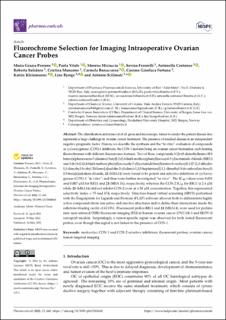| dc.description.abstract | The identification and removal of all gross and microscopic tumor to render the patient disease free represents a huge challenge in ovarian cancer treatment. The presence of residual disease is an independent negative prognostic factor. Herein, we describe the synthesis and the “in vitro” evaluation of compounds as cyclooxygenase (COX)-1 inhibitors, the COX-1 isoform being an ovarian cancer biomarker, each bearing fluorochromes with different fluorescence features. Two of these compounds N-[4-(9-dimethylimino-9H-benzo[a]phenoxazin-5-ylamino) butyl]-2-(3,4-bis(4-methoxyphenyl)isoxazol-5-yl)acetamide chloride (RR11) and 3-(6-(4-(2-(3,4-bis(4-methoxyphenyl)isoxazole-5-yl)acetamido)butyl)amino-6-oxohexyl)-2-[7-(1,3-dihydro-1,1-dimethyl-3-ethyl 2H-benz[e]indolin-2-yl-idene)-1,3,5-heptatrienyl]-1,1-dimethyl-3-(6-carboxilato-hexyl)-1H-benz[e]indolium chloride, 23 (MSA14) were found to be potent and selective inhibitors of cyclooxygenase (COX)-1 “in vitro”, and thus were further investigated “in vivo”. The IC50 values were 0.032 and 0.087 µM for RR11 and 23 (MSA 14), respectively, whereas the COX-2 IC50 for RR11 is 2.4 µM while 23 (MSA14) did not inhibit COX-2 even at a 50 µM concentration. Together, this represented selectivity index = 75 and 874, respectively. Structure-based virtual screening (SBVS) performed with the Fingerprints for Ligands and Proteins (FLAP) software allowed both to differentiate highly active compounds from less active and inactive structures and to define their interactions inside the substrate-binding cavity of hCOX1. Fluorescent probes RR11 and 23 (MSA14), were used for preliminary near-infrared (NIR) fluorescent imaging (FLI) in human ovarian cancer (OVCAR-3 and SKOV-3) xenograft models. Surprisingly, a tumor-specific signal was observed for both tested fluorescent probes, even though this signal is not linked to the presence of COX-1. | en_US |

